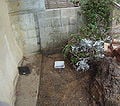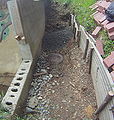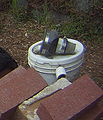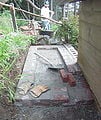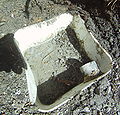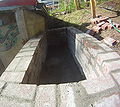
Background[edit | edit source]
Why pay for water when it falls into our laps every year? We have barely begun to take advantage of the free resource potential of rainwater. Instead of wasting energy to distribute water after gravity has already brought it to its lowest elevation, we can capture the water before it falls too low to use and let gravity work for us instead of against us. The CCAT greenshed is in need of a working rainwater catchment system that can supply a hand washing station and food garden with sufficient water. CCAT had one installed in the spring of 2011, but due to a lack of head the system could not provide enough pressure to supply a sink and faucet with water. This project will improve the design and create a system that works and provides water for the Food Forest.
Problem statement[edit | edit source]
The objective of this project is to design and construct a rainwater catchment system for the CCAT greenshed which can be fed to a hand washing station as well as the Food Forest. The new design will solve the issue of insufficient head to supply a sink with water, and it will effectively recycle the water back into the garden or greywater marsh. Any excess water not used by the hand washing station will flow into the Food Forest.
Criteria[edit | edit source]
| Criteria | Constraints | Weight (0-10) |
|---|---|---|
| Functionality | Must provide adequate flow to hand washing station and allow flow to reach the Food Forest. | 10 |
| Cost | Must be within budget. (~$400 total) | 6 |
| Efficiency | Must function without leaks in the system. | 7 |
| Durability | Must withstand water pressure over time and resist sediment build up and clogging. | 8 |
| Aesthetics | Must compliment straw slip wall and have signage. | 5 |
| Locality | Materials must not come from farther than 100 miles away. | 3 |
| Accessibility | Must be easily accessible for future modifications or repairs. | 4 |
| Embedded Energy | Materials used must have little embedded energy | 5 |
Costs[edit | edit source]
CCAT already has many usable materials available, like pvc pipe and storage tanks. There are already gutters and a first flush system set up from the previously attempted handwashing station.
| Quantity | Material | Source | Cost ($) | Total ($) |
|---|---|---|---|---|
| - | PVC Pipe | CCAT | Free | Free |
| - | Gutters | CCAT | Free | Free |
| 4 | Fittings | Ace | 16.00 | 16.00 |
| 480 | Bricks | Ace | .50 | 240 |
| - | Concrete | Pearson Co. | 60.00 | 60.00 |
| 1 | Faucet | Pearson Co. | 10.00 | 10.00 |
| 1 | Drainage Grate | Ordered online | 15.00 | 15.00 |
| 1 | First Flush System | CCAT | Free | Free |
| Total Cost | $341.00 | |||
Proposed Timeline[edit | edit source]
| Objectives | Completion Date |
|---|---|
| Set up collection tanks | March 3rd |
| Construct drainage system | March 10th |
| Construct handwash station wall | Mar 24th |
| Connect faucet and overflow system | March 24th |
| Test System | March 31st |
| Add Signage | March 31st |
| Complete Appropedia page | April 6th |
Literature Review[edit | edit source]
We're not re-inventing the wheel, let's find out what's out there first.
Rainwater Harvesting Basics[edit | edit source]
People throughout the world travel large distances to retrieve water for their daily needs. A functional rainwater harvesting system can liberate females across the globe from this daunting task. Before you go out and help the world there are some basics that you need to know. First, gravity is your friend not your enemy. Second, the roof should be adequate and be of the right surface materials. Third, does the quality of the water being contained satisfy the needs? In other words, don't triple purify your water if your going grow your plants with it.[1]=== Rainwater Harvesting Concerns ===
Some concerns over the project include its aesthetic value. Ideally, we would like to incorporate some more natural looking features into the final product. Another concern is where the water is going to be diverted to after it passes through the wash station and the drain. The system will be a simple design with hopes to eliminate a lot of unforeseen problems.
Types of Rainwater Harvesting Devices[edit | edit source]
There are basically four different types of rainwater catchment.
Roof Water Catchment[edit | edit source]
These systems can vary between thatched type roofs to mud to galvanized iron. They usually involve a gutter system that channels the water to a centralized tank.
Ground water catchment[edit | edit source]
These systems use a sloped piece of land to funnel water down to an underground storage tank.
Rock catchment[edit | edit source]
These systems are similar to ground catchment but use rocks to divert the water to a specified pool. In a sense you are creating a natural reservoir.
Passive catchment[edit | edit source]
These systems utilize an aggressive planning strategy to make water flow about to its desired locations.[2]=== Designing interpretive materials ===
According to Pacey and Cullis interpretive materials for rainwater catchment should include a roof, a gutter, a downspout, and some form of storage tank.[3]== Design ==
Originally water collection tanks were going to be used, but we decided to build a brick trough instead, for its durability, aesthetics, and capacity. PVC pipe was lain down from the base of the retaining wall to the bath tub by the food forest. A bucket was put in place with a grate on top to catch the falling water. Gravel was spread around the area where the trough is as a base layer, then boards were placed over the gravel to help create a level surface for the bricks. The trough was built with two brick thick walls to withstand water pressure. A faucet was placed near the base of the tank, and the bottom of the tank was raised to the faucet's level with mortar to avoid standing water. The inside was lined with an old water bladder, which can be removed for maintenance or cleaning if necessary.
- Components and Process
-
The bucket in place after pipe was laid down
-
Trough location before construction
-
First Flush from previous project
-
Base layer of trough
-
Space left for faucet
-
Bucket filled with concrete to avoid large amounts of standing water
-
Faucet in place
-
Stones placed for walkway
-
Complete trough without liner
2012 project team[edit | edit source]
References[edit | edit source]
- ↑ details many types of popular and simple rainwater catchment systems; provides construction techniques; gives information on rainwater quality; and discusses social, economic, and political impacts of rainwater harvesting. Gould, John, and Erik Petersen. Rainwater catchment systems for domestic supply: design, construction and implementation. London: Intermediate Technology Publications, 1999. Print.
- ↑ Provides information on data collection, designs for drinking water systems, and runoff farming systems. Levario, Heather. Design for water: rainwater harvesting, stormwater catchment, and alternate water reuse. Gabriola Island, B.C.: New Society Publishers, 2007. Print.
- ↑ Describes the components and workings of rainwater catchment systems, provides details for equipment needed, and describes some passive rainwater catchment designs. Pacey, Arnold, and Adrian Cullis. Rainwater harvesting: the collection of rainfall and run-off in rural areas. London: Intermediate Technology Publications, 1986. Print.
